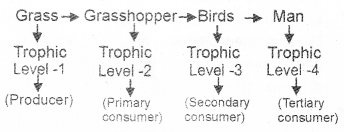Kerala Plus Two Botany Chapter Wise Previous Questions Chapter 7 Ecosystem
Question 1.
During a study tour teacher showed the primary colonisers on the banks of the river ‘Nila’.(MARCH-2010)
a) Identify the succession and justify your answer.
b) List the different stages of the identified succession.
Answer:
Succession taking place in water is called Hydrarch .
b) Phytoplankton stage -> Submerged plant stage -> Submerged free floating plant stage -> Reed swamp stage -> Marsh meadow -> Scrub stage -> Forest stage
Question 2.
While learning trophic levels in class-room, teacher asked you to explain ‘standing crop’ to Raman. Explain. (MARCH-2010)
Answer:
Standing crop – The mass of living material present in each trophic level.
Question 3.
Pond is a self-sustainable unit. Some organisms related to pond ecosystem is listed below, tadpole, fish, water, plants, kingfisher. (MAY-2010)
a) Construct a food chain with the listed organisms.
b) Explain trophic level.
c) Point out trophic level of each organism in the constructed food chain.
d) Name interconnection of food chains in nature.
OR
Two students, Unni and Kannan studied inter specific interactions between different species. They made a table assigning a ‘+’ for beneficial interaction, for detrimental and ‘0’ for neutral interaction. Can you help them by naming the interaction between species in different cases ? Write one example for each interaction.
| Case number | Species A | Species B |
| 1. | + | + |
| 2. | – | – |
| 3. | + | – |
| 4. | + | 0 |
Answer:
Water plants Tadpole -> Fish -> Kingfisher
b) Specific place of an organism in the food chain based on the source of nutrition or food.
c)

d) Food web
OR
1-Mutualism Eg; Lichen
2-Competition
Eg: Competition for food (Phytoplankton) between Flamingoes and fishes
3 – Predation Eg: Lion and Deer
4 – Commensalism
Eg: Epiphyte, Vanda and Mango tree
Question 4.
Consider pond as an ecosystem showing the number of individuals in the following categories. (MARCH-2011)
Carnivores-2500, Producers-15000, Herbrivores- 5000
a) Draw the pyramid of numbers in this ecosystem.
b) Comment on the energy flow in the ecosystem
Answer:
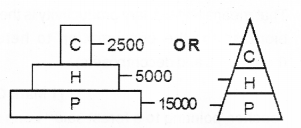
b) Unidirectional flow of energy from producers to consumers. It decreases in successive trophic levels
Question 5.
The gradual change in the species composition of a given area leading to the formation of climax community is called ecological succession. In a rocky area, (MARCH-2011)
a) What is the expected type of pioneer species?
b) How this pioneer species leads to the establishment of a stable climax community?(2 Scores)
Answer:
a) lichens
b) lichens -> mosses -> herbs -> shrubs ->forest.
These are different stages and leads to stable climax community.
Question 6.
Fill up the blanks with appropriate terms in the given pyramid of trophic level: (MAY-2011)
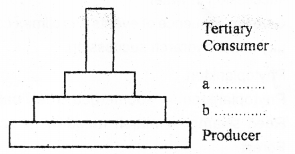
Answer:
b – Primary consumer a- secondary consumer
Question 7.
Kalyani wrote man, hen, earthworm, mango-tree in her note book. Arrange the terms in a food chain sequence. Explain food chain and name the types of food chain. (MAY-2011)
Answer:
Earth worm—> Hen —> Man —> Mango tree
The transfer of food from the producers through a series of organisms with repeated eating and being eaten is referred to as Food chain Detritus food chain
Question 8.
In a marine ecosystem, a population of phytoplankton (150,000) supports a standing crop of fishes (40,000). (MARCH-2012)
a) Draw the pyramid of biomass and
b) The pyramid of numbers in this ecosystem,
Answer:
a) Inverted Pyramid
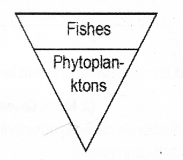
b) Upright Pyramid
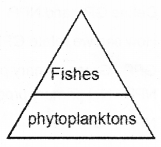
Question 9.
The gradual and fairly predictable changes in the species composition in an area is called ecological succession. (MARCH-2012)
a) Name the pioneer species in the primary succession in water.
b) Give the sequence of events and climax community in the hydrarch succession.
Answer:
a) Phytoplankton
b) Phytoplankton -> submerged free floating -> Reed swamp marsh meadow -> scrub -> Forest.
Question 10.
Given number of individuals in a grassland ecosystem. (MAY-2012)
Grasshopper – 1500
Grass – 5,842,000
Wolf – 28
Birds – 215
a) Draw a pyramid of numbers showing various trophic levels.
b) Explain trophic level.
Answer:
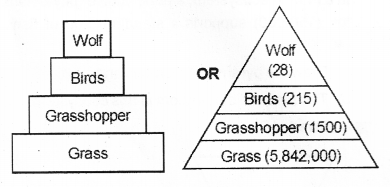
b) Each step in food chain is called trophic level
Question 11.
Rate of biomass production is called productivity and can be divided into GPP and NPP : (MAY-2012)
a) Define GPP and NPP.
b) How can we relate GPP and NPP?
Answer:
a) GPP – Gross primary productivity NPP – Net primary productivity
b) NPP = GPP-R
Question 12.
Final community that is in near equilibrium with environment in ecological succession is called ________. (MARCH-2013)
Answer:
Climax community
Question 13.
Natural interlinked food chains are called _______. (MARCH-2013)
Answer:
Food web
Question 14.
A list of organisms are given. Place them in different trophic levels. Grass, Man, Fishes, Birds, Lion, Grasshopper, Zooplankton, Trees. (MARCH-2013)
Answer:
First trophic level – trees,grass
Second trophic level – grasshopper,zooplankton
Third trophic level – birds, fishes
Fourth trophic level – lion ,man
Question 15.
In the equation, GPP-R = NPP; If NPP = Net primary productivity. (MAY-2013)
Explain GPP – R = NPP.
Answer:
Gross primary productivity minus respiration losses (R) is the net primary productivity (NPP).
That means Net primary productivity is the available biomass for the consumption to heterotrophs (herbiviores and decomposers).
Question 16.
Teacher, pointing to a forest said “ Long back, this place was a pond’’. This gradual change is an example of (MAY-2013)
1) Secondary succession
2) Xerarch succession
3) Pioneer species
4) Hydrarch succession
Answer:
Hydrarch succession
Question 17.
The species that invade a nude area are called ________ species. In a primary succession on rocks, the group that invade first are usually. (MARCH-2014)
Answer:
Pioneer species, Lichens
Question 18.
The rate of biomass production in an ecosystem is called productivity. They are of two types, gross primary productivity and net primary productivity, how these two productivities are related? (MARCH-2014)
Answer:
Gross primary productivity of an ecosystem is the rate of production of organic matterduring photosynthesis.
Gross primary productivity minus respiration losses (R), is the net primary productivity (NPP).
i.e: GPP – R = NPP
Question 19.
A list of different organisms in an ecosystem are given below. (MARCH-2014)
Arrange them in 1st, 2nd, 3rd and 4th trophic level,
i) Phytoplankton
ii) Man
iii) Fish
iv) Zooplankton
Answer:
![]()
Question 20.
By observing the relationship of the first pair fill up the blanks: (MAY-2014)
a) Grazing food chain consists of producers and consumers whereas Detritus chain comprises dead organic matter and ______.
b) Nitrogen : Gaseous cycle
Sulphur: _______
Answer:
a) Detrivores
b) Sedimentary cycle
Question 21.
Field survey by a team of students recorded the following data related to biomass of the organisms in each tropic level of an ecosystem. Draw, name and explain the pyramid (MAY-2014)
Answer:

Biomass increases in successive trophic levels hence the pyramid given here is inverted.
Question 22.
Gradual, sequential changes of a given area including species composition is known as ecological succession. If so name the first two stages of the succession in hydricarea. (MAY-2014)
Answer:
1) phytoplankton stage
2) submerged plant stage
Question 23.
Primary succession on rocks is known as Xerosere. Answer the following related with Xerosere. (MARCH-2015)
a) Name the pioneer community.
b) Organic acids have important roles in this succession. Justify.
Answer:
a) Lichen
b) It helps in weathering of rocks and soil formation
Question 24.
By observing the relationship of the first pair fills up the blanks. (MAY-2015)
a) Net primary productivity =
Gross primary productivity — Respiration.
Gross primary productivity is ________.
b) Carbon: Gaseous cycle
Phosphorus: ______.
Answer:
a) total organic matter
b) sedimentary cycle
Question 25.
Field survey by a team of students recorded the following data related to number of organisms in an ecosystem and plotted that into a figure shown below: (MAY-2015)

Observe the figure and explain the pyramid.
Answer:
It is the inverted pyramid . In this number of organism increases in the successive trophic levels.
Question 26.
Hydrosere succession stages are given below. Arrange them in order. (MAY-2015)
Scrub stage — forest —submerged free floating — Marsh Meadow —Submerged stage —Reed swamp—Phytopiankton.
Answer:
Phytoplankton- submerged-submerged free floating- reed swamp -Marsh meadow -srub stage – forest.
Question 27.
Nutrients are never lost from the ecosystems and are recycled. Write about. (MARCH-2016)
a) Gaseous cycle
b) Sedimentary cycle
Answer:
a) Gaseous cycle- The reservoir of gaseous type nutrients are present in atmosphere
b) Sedimentary cycle- The reservoir of nutrients are present in earth crust
Question 28.
Ecological pyramids are usually upright. Meanwhile some, pyramid of biomass is inverted. Explain the reason. (MARCH-2016)
Answer:
Pyramid of biomass of sea is inverted because biomass of fishes far exceeds phytoplankton
Question 29.
a) Biogeochemical cycle is an important phenomenon in very ecosystem. Describe phosphorus cycle. (MAY-2016)
OR
b) The plant communities in a given area show successive changes. Mention the stages of succession in a xerosere.
Answer:
a) The cycle consists of following steps.

OR
b) In xerach succession first plant communities appear in bare area are lichens,They secrete
carbonic acid and dissolve rocks. This process forms soil that help in the growth of mosses. Then herbs,shrubs and forest stage appears .this process takes thousands of years and form climax community.
Question 30.
Earthworms are commonly referred as farmers’ friends. Define fragmentation. (MAY-2016)
Answer:
During fragmentation large detritus (dead remains of plants & animals) is converted into into smaller particle by the detritrivores like earthworm, its surface area increases that helps in process, of decomposition.
Question 31.
The different stages of primary succession in water are represented below. Fill the gaps that are unfilled. (MARCH-2017)
a) Phytoplankton
b) _______
c) Submerged free floating plant stage
d) _______
e)________
f) Shrub stage
g) _______
Answer:
a) phytoplankton stage.
b) Submerged plant stage.
c) Submerged free floating plant Stage
d) Reed swamp stage.
f) Marsh – meadow stage
g) Scrub stage.
h) Forest stage
Question 32.
An ecosystem consist of the following population: (MARCH-2017)
Phytoplankton
Man
Fish
Zooplankton
Draw a food chain denoting each trophic level
Answer:
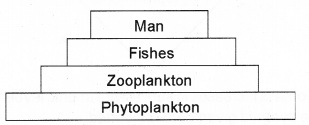
Question 33.
The natural reservoir of phosphorous is rock where it is present in the form of phosphates. How this phosphorous is cycled in ecosystem? (MAY-2017)
Answer:
The reservoir of phosphorus is rock. During weathering process orthophosphates reaches the soil solution. It is taken by plants, that passes through food chain and reaches animals. After the death and decay, the organic form of phosphorus is coming into the soil solution as orthophosphates by the activity of phosphate solubilising bacteria.
Question 34.
Birds represent members in a food chain. (MAY-2017)
Draw a food chain representing each of the above in different tropic levels.
Answer:
